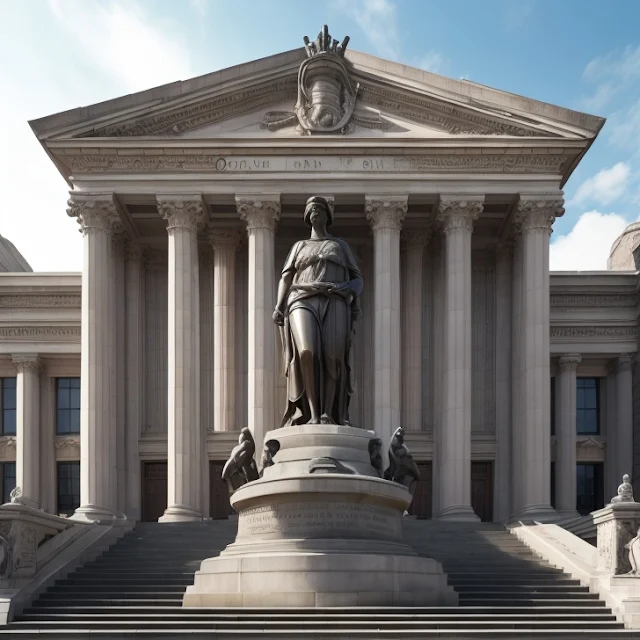- Get link
- X
- Other Apps
- Get link
- X
- Other Apps
Where Law Ends Tyranny Begins on What Building
In a world where power dynamics often play a pivotal role in shaping societies, the relationship between law and tyranny becomes particularly intriguing. The intersection of these two seemingly disparate concepts can manifest in unexpected ways, with buildings becoming both symbols of authority and tools of oppression. This article embarks on a journey to unravel the intricacies of the phrase "where law ends tyranny begins on what building," shedding light on the delicate balance and societal implications.
( Read our article on Where Law Ends )
The Thin Line Between Law and Tyranny
At its core, the saying underscores the precarious equilibrium between legal regulations and oppressive rule. Laws, which are designed to safeguard justice and individual rights, can inadvertently pave the way for tyranny when unchecked power is allowed to flourish. This delicate balance hinges on interpretations, enforcement, and the vigilant oversight of laws.
The Role of Buildings in this Conundrum
Buildings, both in their physical presence and symbolic significance, often come to embody power and control. Throughout history, certain structures have been strategically employed to enforce laws or project authority. The architecture of a building can influence not only the functions it serves but also the emotions and perceptions it evokes, further blurring the line between law and tyranny.
The Dynamics of Law and Tyranny in Architecture
The architectural design possesses a unique ability to influence the execution of laws and regulations. Buildings can be deliberately crafted to uphold justice, with spaces that facilitate transparency, fairness, and civic engagement. Conversely, architectural choices can inadvertently provide spaces for tyranny to flourish, allowing for surveillance, control, and subjugation.
Where Does Law Fall Short?
While legal systems are intended to be safeguards against tyranny, they can sometimes fall short in addressing evolving societal challenges. Gaps and loopholes within laws can be exploited for oppressive purposes, leading to a deterioration of justice and individual freedoms. The dynamic nature of governance requires constant vigilance to prevent the encroachment of tyranny.
The Rise of Symbolic Tyranny
Certain buildings become symbols of authority, often used to assert control over a populace. Whether through grand government structures or imposing palaces, architecture can visually reinforce power dynamics and create an atmosphere of subservience. Iconic buildings can evoke feelings of awe, but they can also serve as reminders of unchecked authority.
Navigating the Complexities: Balancing Power
The delicate balance between law and tyranny necessitates strategies to uphold justice while preventing the misuse of power. Transparent governance, citizen participation, and effective oversight mechanisms are crucial to preventing the slide into oppression. By engaging with the intricacies of governance, societies can ensure that buildings remain symbols of progress rather than tools of control.
Case Studies: Buildings as Instruments of Tyranny
Throughout history, there are numerous instances where buildings have been used as instruments of tyranny. From oppressive regimes using grand structures to project dominance to modern examples of surveillance-equipped buildings, these cases underscore the potential consequences of unchecked power.
The Power of Architecture in Resistance
Amidst the potential for buildings to be used for oppression, architecture also serves as a form of resistance. Communities can repurpose spaces, creating safe havens that foster freedom and inclusivity. Buildings can become embodiments of collective resilience, providing hope and inspiration in the face of tyranny.
The Human Factor: Voices Against Tyranny
While buildings hold symbolic power, it is ultimately individuals and communities that drive change. Voices raised against oppression, combined with collective action, can challenge the status quo. By harnessing the power of unity, societies can dismantle structures of tyranny and usher in a new era of justice and freedom.
Conclusion
In our exploration of "where law ends tyranny begins on what building," we've journeyed through the complex interplay between law, power, and architectural symbolism. The delicate balance between justice and oppression requires constant vigilance and a nuanced perspective. By understanding how buildings can shape power dynamics and influence societal narratives, we can work towards a future where the built environment serves as a beacon of progress and equality.
FAQs
Q: Can buildings truly become instruments of tyranny?
A: Absolutely. Throughout history, there have been instances where buildings were used to assert control and subjugate populations.
Q: How can architecture resist tyranny?
A: Architecture can provide spaces of resistance by fostering inclusivity, offering refuge, and challenging oppressive norms.
Q: Are there positive examples of buildings promoting freedom?
A: Yes, buildings like community centers and spaces of activism showcase how architecture can be harnessed to empower individuals.
Q: What can individuals do to prevent buildings from becoming tools of tyranny?
A: By advocating for transparent governance, engaging in civic participation, and promoting accountability, individuals can prevent the misuse of architectural power.
Q: How does understanding the dynamics between law and buildings contribute to societal progress?
A: Understanding this dynamic helps us shape a built environment that upholds justice, empowers communities, and prevents the slide into oppression.
( Powered by GCC Law-SA )
Building Implications
Intersection Insights
Law vs. Freedom
Legal Boundaries
Tyranny and Architecture
- Get link
- X
- Other Apps

Comments
Post a Comment